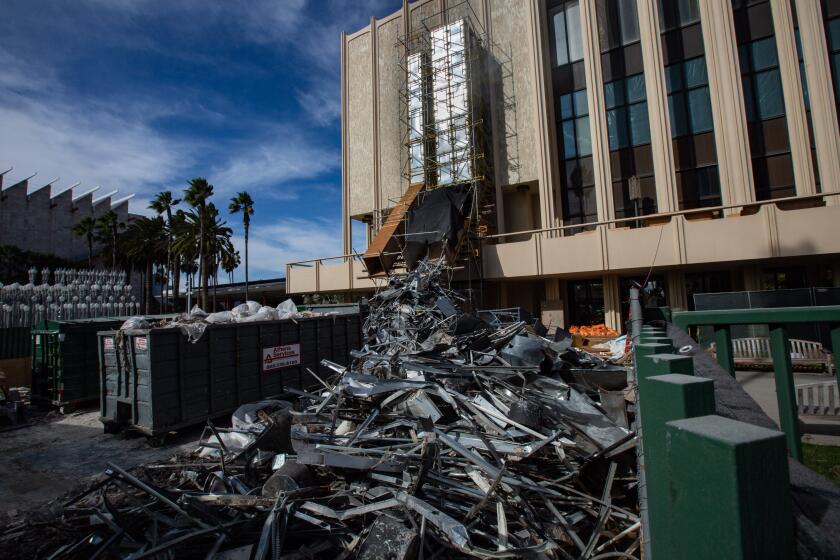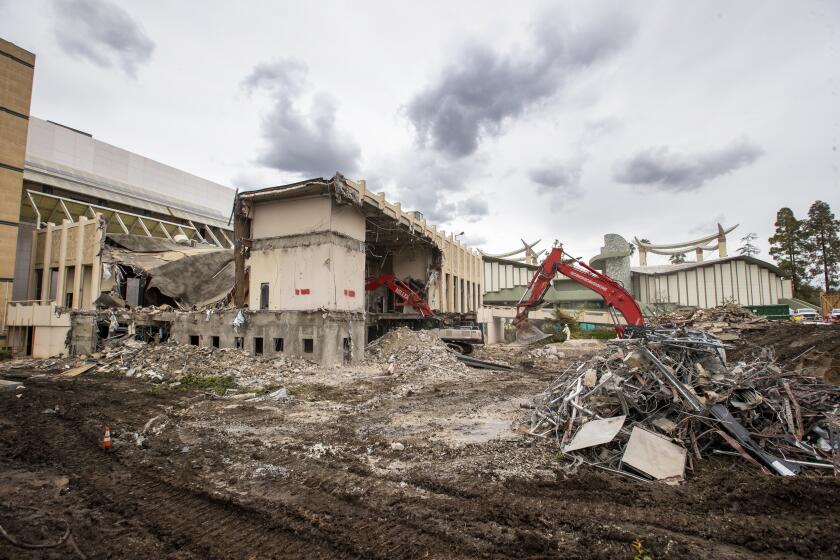Commentary: LACMA has begun demolition. Where are the gallery plans?
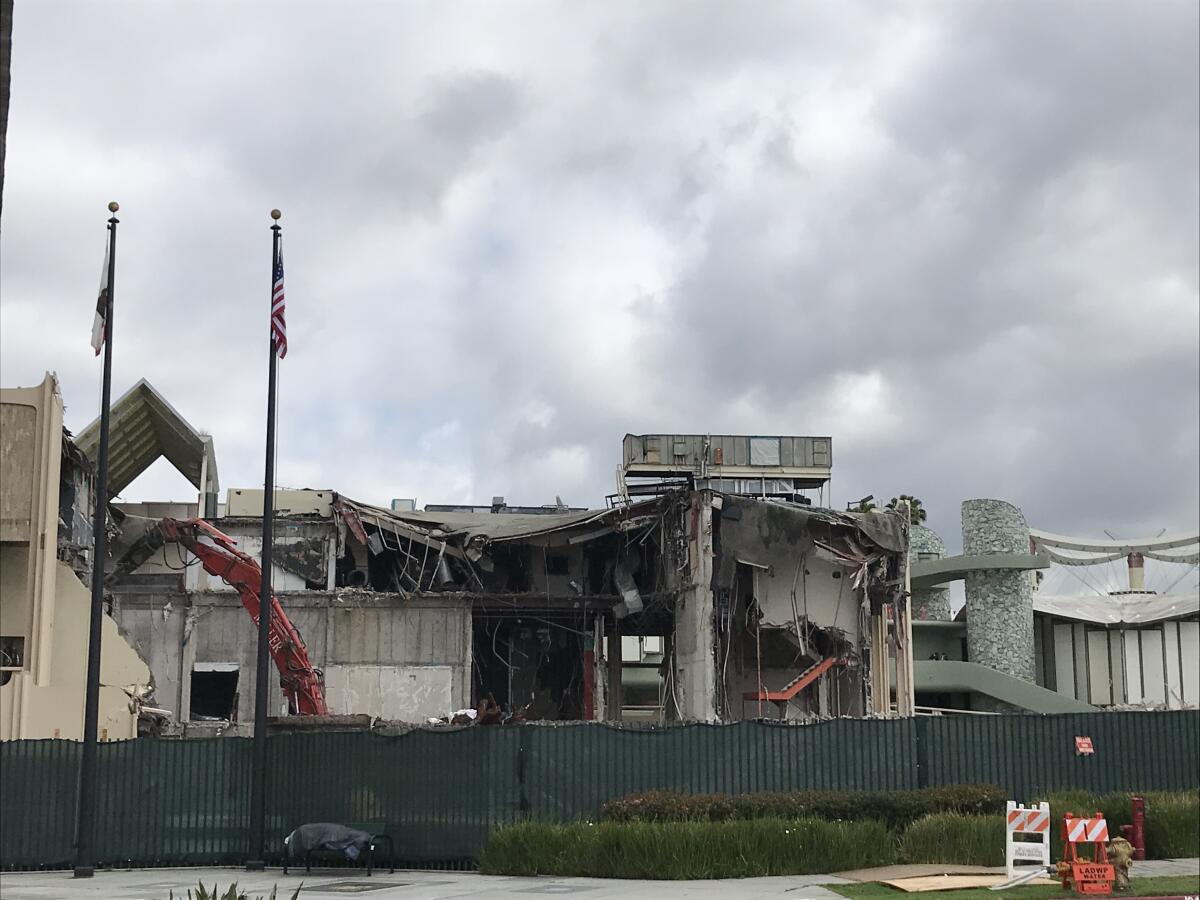
- Share via
Early last week, if you’d been cruising through the Mid-Wilshire area, you might have caught sight of a wrecking crew beginning to pry apart the Bing Theater at the Los Angeles County Museum of Art. But chances are you didn’t catch sight of it because Los Angeles has been under quarantine for almost a month.
In late March, the museum told Times reporter Deborah Vankin that it would proceed with its planned $750-million building project designed by Peter Zumthor — and that demolition was scheduled to begin sometime in April. But surely it would have been nice — er, transparent? — to give Angelenos a heads-up that workers had actually begun tearing apart a county building that had been part of the city’s landscape for more than half a century.
The museum didn’t address the demolition in a fully public way until April 9, via a blog post on its website published three days after it had begun and two days after The Times had published a story on the subject. The post described the controversial building project as “an important source of job creation.”

All of this raises the question of where exactly things stand with the building’s design — specifically plans for the interior, which have yet to be shown to the public. The museum has circulated conceptual renderings of what the gallery spaces may look like, but no final floor plan has been released.
In February, in a story I reported about concerns over the museum’s debt load, LACMA‘s director, Michael Govan, said the plans would be made public sometime in March. Now, he says, the release of those plans has been pushed back by the pandemic.
“We have spent the last month 24/7 navigating the COVID-19 crisis,” Govan stated in an email. “Delayed for good reason, we are still working to finish our better presentation about the gallery designs that is more complete, including the curatorial perspectives that shaped the program.”
He expects to be able to share “more descriptive materials about how the galleries work” within “the next 4-6 weeks.”
LACMA, like so many institutions around the world, has had day-to-day life overturned by the COVID-19 pandemic, shutting galleries and forcing staff to work remotely. Unlike many other institutions, the museum has not laid off any staff in the wake of the quarantine.
But the floor plans should never have been affected by coronavirus to begin with. The museum should have released them — some semblance of them — months ago.
Or how about a year ago, when a revised design was presented to the County Board of Supervisors for a crucial vote as part of the environmental impact approval process? The supes didn’t seem all that preoccupied by the incomplete nature of the designs and rubber-stamped the plan, unanimously releasing $117.5 million in county funds for the project. They may have been distracted by Brad Pitt, whom LACMA took to the meeting as a celebrity booster.
When New York’s Museum of Modern Art announced its renovation and expansion plan in 2014, it issued a set of simple schematics that showed how the new spaces would attach to the existing museum and which of these would be devoted to showing art. Three years later, as the renovation wrapped and construction of the new wing got rolling, the museum issued a more detailed plan that provided the particulars of circulation and the location of amenities.
LACMA — a museum that draws anywhere from a fifth to a quarter of its annual budget from the taxpayers of the County of Los Angeles — has provided no such information to the public. And in LACMA’s case, the information is even more critical given the building’s unusual form and the fact that part of the intent of the design is to rethink the ways in which permanent collections are shown.
Govan stated via email that the Zumthor building will include 110,000 square feet of gallery space, a “bigger and better” version of Ray’s and Stark Bar, a gift shop, two loading docks, an education facility, a theater and two cafes. But how any of these might be configured within a building that is shaped like a moose antler is still a mystery.
Michael Govan responds to critics who say building a new Peter Zumthor-designed complex will leave the museum swimming in debt. With demolition just weeks away, we look at LACMA’s tax forms and current debt load.
What is certain is that neither the demolition nor the pandemic has put a damper on the activities of the two groups that have been actively protesting the construction plan: the nonprofit Save LACMA and the more ad hoc Citizens’ Brigade to Save LACMA.
Late last month, Save LACMA, led by nonprofit consultant Rob Hollman, filed the initial paperwork for a county ballot measure that could implement changes to the ways in which LACMA operates and the ways in which it might undertake construction projects in the future.
The initiative would:
- require a public design competition for any “modifications and/or additions to the museum’s campus”
- limit the percentage of county funds that could be employed in future museum building projects to 20%
- require that governmental representatives from the county and city serve on the museum’s board.
If the county approves the submission, Hollman says his organization will get to work gathering signatures — they will need 225,000 — to get it on the November ballot. Though how signature collecting will be achieved in the age of social distancing remains to be seen.
Regardless, Hollman says his organization is charging ahead. “I got a snarky email from a former [LACMA] board member saying that maybe I have too much time on my hands,” he says. “I actually don’t. I have two kids at home and we have to teach them. My question is, why are they approving this?”
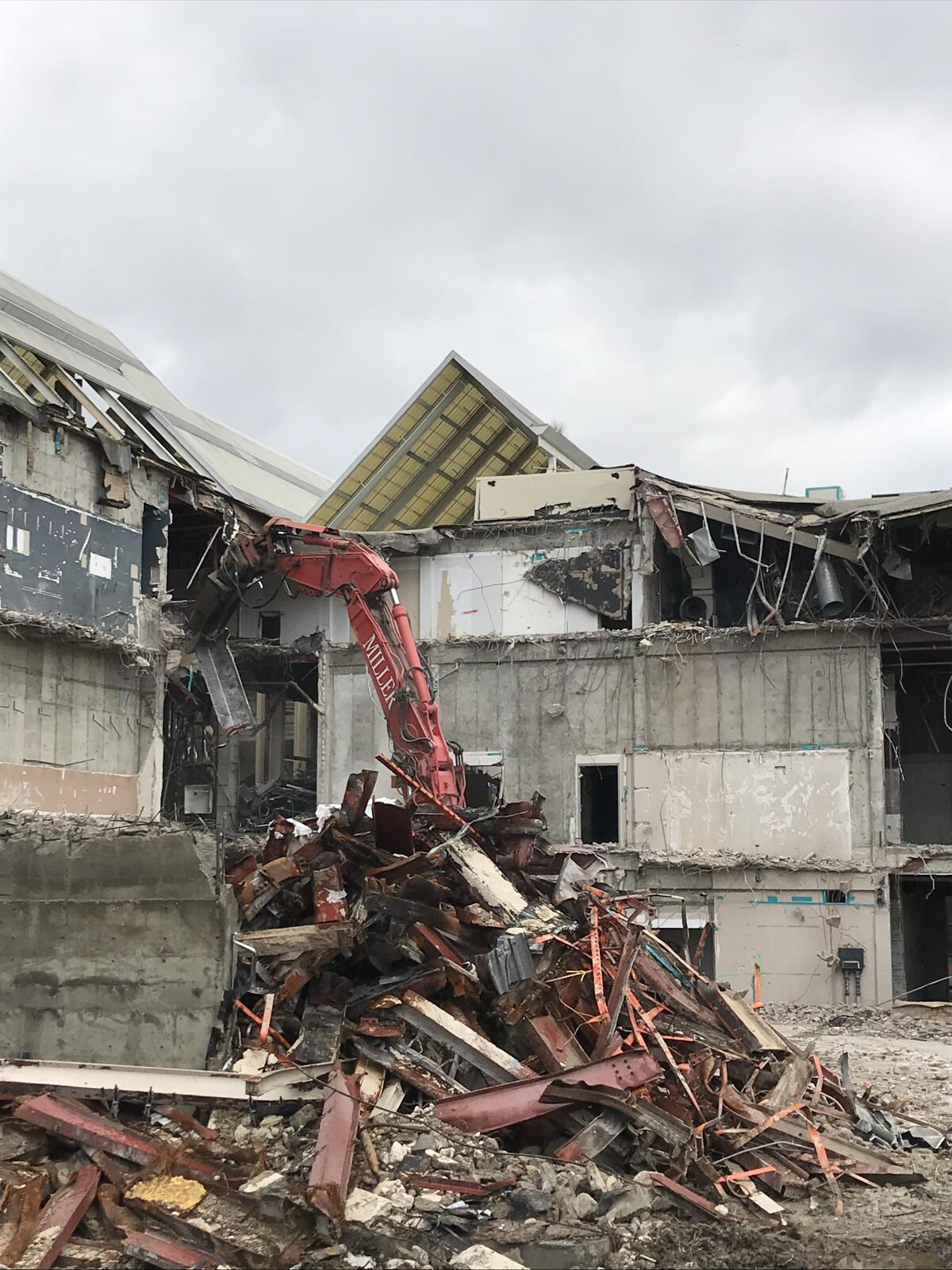
The more loosely organized Citizens’ Brigade, an informal organization spearheaded by architecture writers Greg Goldin and Joseph Giovannini, is moving forward with its own plans.
On the heels of the demolition reports, the Brigade launched a letter-writing campaign to the museum’s board with a variety of email templates that, like a restaurant menu, can be chosen by levels of hotness.
The “mild” template, which features a one chile pepper rating, urges board members: “Stop the demolition now. Halt construction. Hold an international architectural competition to get a bigger and stronger — not a smaller and weaker — LACMA.”
The “on fire” choice — five chiles — reads: “Look in the mirror and live with the disgrace of knowing you cheated Angelenos out of the museum they loved.”
They also launched a pop-up architectural competition to redesign LACMA’s east campus. Proposals are due by midnight Wednesday.
“We got 73 inquiries followed by intent to submit,” Goldin stated by email.
In the meantime, LACMA is busy demolishing three structures designed by the firm of William Pereira in the 1960s, along with an addition by Hardy Holzman Pfeiffer Associates from the 1980s.
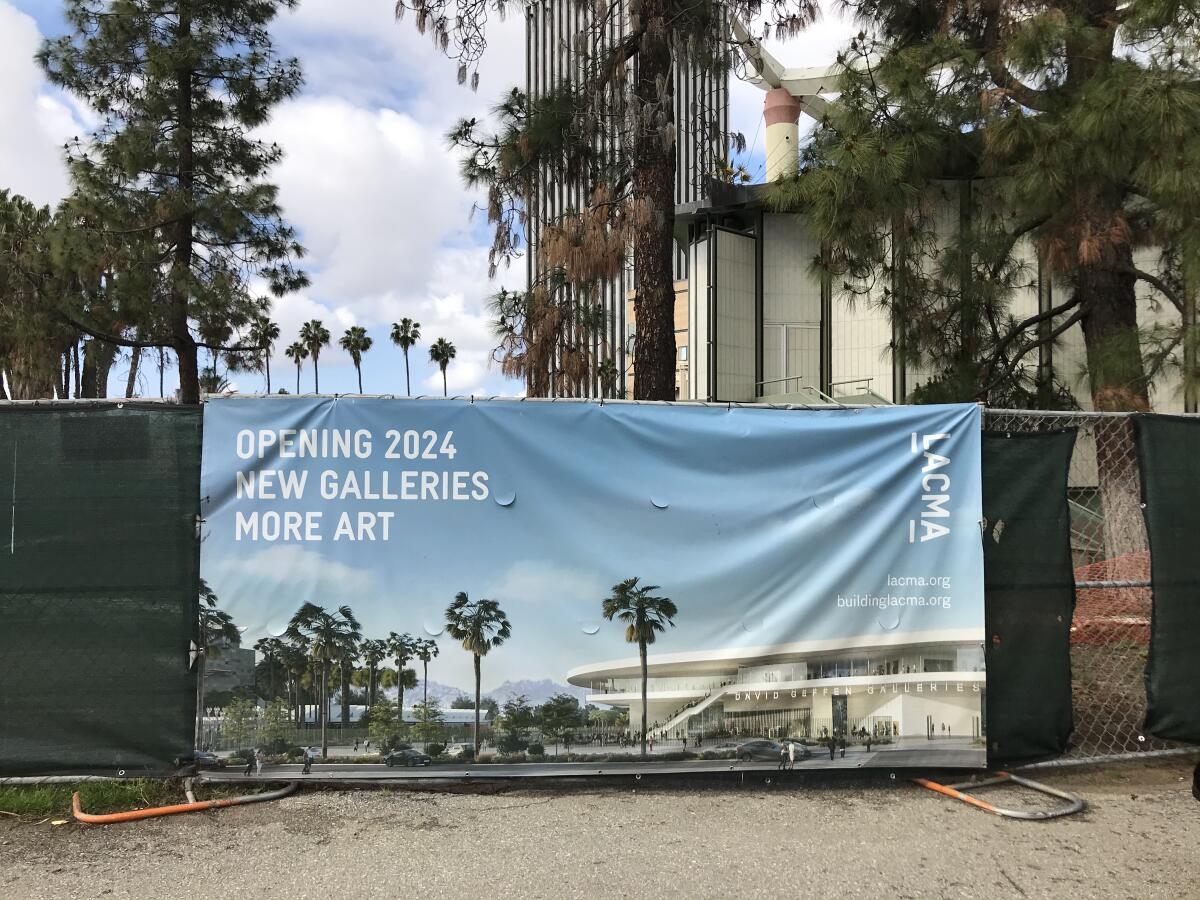
The Bing Theater was part of the suite of buildings designed by Pereira for the museum’s original campus in 1965. It was inaugurated by French composer Pierre Boulez, who premiered a new work for the occasion: “Éclat,” a piece for 15 instruments that is inspired by ideas of resonance.
Over the course of its life, the Bing was the site of countless other classical music concerts, as well as artist talks and film screenings. In 2013, I saw a stirring presentation of Luis Buñuel’s “Los Olvidados” in connection with an exhibition about Mexican cinematographer Gabriel Figueroa.
When word of the theater’s demolition got out, filmmakers and aficionados rushed to pay tribute on social media. A great place to view the classics,” wrote Joe Dante, who directed popular ‘80s pictures like “Gremlins” and “The ‘Burbs.” Film critic Kenneth Turan, who retired from his post as Times film critic earlier this month, described it as “one of the best of L.A. movie showcases.”
On Monday morning, nothing appeared to remain of the Modernist, wood-paneled interior. All that was left was a shell — being demolished by an excavator.
Part of what has been so frustrating about the LACMA design process are the questions that remain unanswered at this very late stage: Namely, what this container for art will actually contain.
Designs frequently evolve up to and even during construction — bending to the reality of cost or building codes or the availability of materials. I am not unaware of this. But when it comes to LACMA, there has been nothing more on offer than faith in Zumthor’s vision.
We are now at the stage where there’s a giant hole in the ground where the Bing Theater once stood. And the only thing filling it is a very large shrug: \_(ツ)_/.
Crews begin demolishing four structures. Check back for more photos, including drone views, as one L.A. landmark makes way for another.
More to Read
The biggest entertainment stories
Get our big stories about Hollywood, film, television, music, arts, culture and more right in your inbox as soon as they publish.
You may occasionally receive promotional content from the Los Angeles Times.
